"The day science begins to study non-physical phenomena, it will make more progress in one decade than in all the previous centuries of its existence." ? [Nikola Tesla]
In any serious analysis of the ether it is paramount to acknowledge the Victorian age (1832-1901) compared to the post Victorian or modern age of quantum physics from 1901 onwards. In terms of this analysis we can say with good intent the Victorian science age ended in 1896 with the isolation and quantification of the electron by J. J. Thomson et al. The point of interest is the atom was considered indivisible up to 1896. After 1896 it became impossible to hold onto the indivisible atom theory and it became obvious atoms were composed of smaller "sub atomic" corpuscles. The idea atoms were indivisible seems to have originated as far back in time as the 5th century BCE with Leucippus. To the Victorian scientists then the atom was indivisible hence 1) there was nothing smaller than an atom yet their logic told them 2) there was something else other than atoms that could not be isolated physically yet this other substance had to be there to account for propagation of light, heat, etc. They called this unknowable substance aether, ether, luminiferous ether, etc..
It is the premise of this writer their mysterious ether is a general classification encompassing all of our crowded quantum realm of elementary and composite particles and forces. He called his field of research Sympathetic Vibratory Physics, Etheric Physics or simply Vibratory Physics. Today this field has several divisions; particle physics, quantum mechanics, quantum field theory, condensed matter physics, quantum electrodynamics, quantum chromodynamics, high energy nuclear physics and various other related fields. All of these fields were unknown to Victorian science.
Because the beliefs of the Victorian scientists did not permit them to acknowledge anything smaller than an atom their orthodox beliefs (dogma and doctrine) prevented them from investigating with or without prejudice any ideas or theories which included the dissociation of atoms into their constituent or aliquot parts - or the investigation into these etheric (quantum) entities and their forces and dynamics.
This very human state of affairs persisted until the investigatory work and collaboration of many scientists prior to and after 1896 around the discovery and theoretical development of the electron - the first real subatomic or quantum particle to be acknowledged and accepted by the credentialed scientific community.
There was however one inventor and discoverer who defied all orthodoxy with its paralyzing dogma and doctrine launching himself without fear into these unknown waters. His name was John Ernst Worrell Keely (1827-1898). Mr. Keely began his investigatory work in the 1860s relentlessly pursuing his goals of limitless power until his death in 1898. The various forms of energy he discovered were results of dissociating molecules, atoms and various subatomic particles. See further exploration in dissociation of atoms liberates spontaneous energy, dissociating water and dissociating atoms.
"Keely has proved by demonstration (prior to 1893) that the subdivision of matter under different orders of progressive vibration evolves by such subdivision entirely new and distinct elements, too multiple to enumerate." [Bloomfield-Moore]
Currently in particle physics there are 61 recognized elementary particles and numerous composite particles.
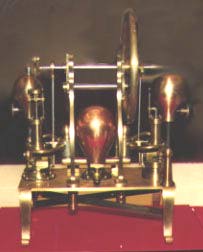
During this time Keely developed two main classes (hydro-vacuo and dynaspheric or globular) of motors each class with many variants to harness the unacknowledged Etheric Force he had discovered. A third class of motor called a Vibrodyne was developed later. He invented countless instruments to detect, measure and control this power. During the development of his discoveries Mr. Keely developed a stunning array of accomplishments many of which were not duplicated until decades later, if at all. Because his work with his etheric or dynaspheric force involved splitting or dissociating the atom, which was anathema to the theories of those scientists surrounding him he was very effectively shunned and ostracized by science. This especially true of the power industry whose owners became alarmed and fearful of Keely’s new forces that would effectively end their monopolized steam, coal and other power industries. False charges of fraud and other calumnies were applied to Keely and his work. There were however a few scientists with vision, honesty and courage who witnessed Keely’s experiments and did cautiously endorse his findings.



Among those scientists was Professor Daniel Brinton, University of Pennsylvania, who spent some time with Keely in his laboratory. Brinton composed an abstract of what Keely was doing and how. This abstract was confirmed as being "perfectly correct" by Keely.
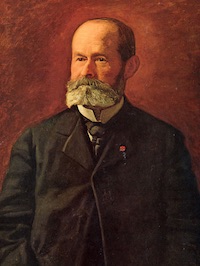
Brinton’s abstract provides an insight into Keely’s paradigm of subatomic particles and the forces creating and the interactions between them that differs in many particulars from the Standard Model. Perhaps the primary difference is Keely understood attraction and repulsion to be created and governed not by "exchange particles for the strong force" but by variable states of harmony and discord of and between the vibrations and oscillations of the particles themselves.
Because there were no named quantum particles during his time Keely identified and gave them names. For instance the first level of subatomic particles he classified as atomoles.
"Atomoles are elementary units of matter uniform in size and weight, and exist in solid, liquid, gaseous, and isolated forms." [Keely, plural atomolini]
Perhaps most revealing is his definition of atoms which show beyond doubt he understood the composite nature of atoms.
"Atoms are multiple combinations of atomoles, and they also exist in solid, liquid, gaseous, and isolated forms." [Keely]
Keely’s work was true disruptive innovation that would have caused a mighty change of direction to society and industry. Small wonder then this man and his work were erased and not brought forward into practical use.
Splitting Atoms is Child’s Play
We have allowed ourselves to be misled into the unfounded belief that splitting atoms requires a Manhattan Project level effort. Splitting atoms is indeed child’s play but refining uranium to make an atom or nuclear bomb indeed does require a massive and expensive effort. Only psychopaths desire atomic and nuclear bombs. We simple folk would like to slow release these energies such that they can be used safely in a practical way.
As we will see below these sub-molecular and subatomic forces and energies are rarely death causing ionization or radioactivity. Natural or low-energy dissociation is actually gentler than a baby’s breath and just as safe.
Nearly every child of my and previous generations has played with cap guns wherein a small quantity of explosive powder is incapsulated in paper on a roll. The sudden compression of this powder introduces a pulse or shock wave that disrupts the harmony of the chemistry resulting in a destruction of the chemicals and their dissociation in atomic and subatomic substances. Flame (heat) and smoke (dissociated complex molecules) are produced in such a child’s toy. Cap guns and their 'ammo' have been around since the 1860s.
We’ve all struck matches and lit candles to enjoy the flame and sometimes aroma of scented candles. A candle flame is plasma. Such plasma shows electrical and magnetic attributes (subatomic features). From whence does this plasma come? It comes from within the complex molecules and atoms of the wax which are dissociated (split) by the discordance of the heat. The actual physics goes deeper than this but simply speaking the heat disrupts the coherence of harmony that holds the molecules and atoms together. The sharp increase of temperature while striking a match introduces extreme discord into the balanced chemistry of the match head igniting it - causing its molecules to dissociate in a flash of heat and photons of light (plasma).
Another everyday illustration of how simply dissociation happens is seen in faded signs along a road or highway. The original bright paint has been sublimated from a solid complex molecular substance into dispersing atomic and subatomic substances by discordant ultraviolet rays of sun light. This happens seemingly without physical effort - just the gentle dissociative chemical action of UV light.
Similarly this disruptive property of UV light dissociating molecules is used everyday to dissociate plastic in the making of printing plates. The process is called photolithography which has been in use since the 1820s. There are countless other industrial processes that make use of this dissociative property of high frequency ultraviolet light.
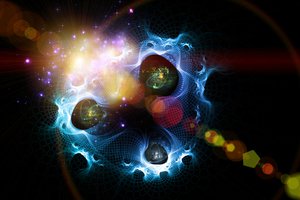
This is a time line of the discovery of the divisibility of the atom. It is clear Keely was the first and most prolific discoverer of this phenomenon. One needs to remember Keely developed an entire quantum paradigm 50 years before there was any quantum anything. He did his work before science recognized the atom was divisible. So he had to develop his own language. Gustave Le Bon claimed first discovery status in 1896 but we can see Keely was prior by at least 20 years. Both Rutherford and J. J. Thomson also made the claim in 1896. [See Keely Chronology, Quantum Mechanics Timeline]
1600 William Gilbert publishes De Magnete, in which he made a careful study of electricity and magnetism.
1637 Rene Descartes proposes wave theory of light.
1643 Evangelista Torricelli's (partial vacuum) mercury barometer.
1650 first vacuum pump was invented in 1650 by Otto von Guericke
1662 Boyle's law published by Robert Boyle.
1665 Robert Hooke proposes wave theory of light.
1668 Christiaan Huygens proposes wave theory of light.
1687 Isaac Newton publishes "Mathematical Principles of Natural Philosophy"; usually called the "Principia"
1710 Benjamin Franklin discerns polar charge.
1752, June; Benjamin Franklin conducts his kite experiment
1791 Luigi Galvani published his discovery of bioelectromagnetics, demonstrating that electricity was the medium by which neurons passed signals to the muscles.
1794 Molecule defined, Rene Descartes[1]
1800 Alessandro Volta develops battery, or voltaic pile
1803 Atom first physical evidence, John Dalton[2]
1818 John Dalton publishes [System of Chemistry].
1821 Michael Faraday invents the electric motor.
1824 first formulation of Second law of thermodynamics is credited to the French scientist Sadi Carnot
1831 Maxwell unifies electricity and magnetism.
1836 Faraday divined when he wrote, in 1836: "Thus, either present elements are the true elements, or else there is the probability before us of obtaining some more high and general power of nature even than electricity, and which at the same time might reveal to us an entirely new grade of the elements of matter, now hidden from our view and almost from our suspicion."
1838-1851 Richard Laming discerns atomic core and electron cloud.
1840 1840, Germain Hess stated a conservation law for the so-called 'heat of reaction' for chemical reactions.
1842 Waterton publishes kinetic theory of gases.
1846 Wilhelm Eduard Weber discerns polar fluids governed by inverse square law.
1847 Helmholtz generalizes conservation of energy law.
1850 Clausis states the first law of thermodynamics.
1856 German glassblower Heinrich Geissler created a mercury vacuum pump that evacuated a glass tube to an extent not previously possible. Heinrich Geissler invented the first gas-discharge lamp, the Geissler tube, consisting of a partially evacuated glass tube with a metal electrode at either end.[30]
June 28, 1856 - Nikola Tesla born
1859 Kirchhoff establishes thermodynamic foundation of radiation theory, Kirchhoffs circuit laws.
1860 Maxwell publishes "Illustrations of the Dynamical Theory of Gases".
1861 Maxwell publishes "On Physical Lines of Force".
1862 Hermann Helmholtz publishes "On the Sensations of Tone" mentioning Helmholtz Resonators.
1863 Cap guns were introduced.[25] Molecular Dissociation
1865 Maxwell publishes "A Dynamical Theory of the Electromagnetic Field".
1865 James Clerk Maxwell predicts light is an electromagnetic wave.
1867 Maxwell publishes "On the Dynamical Theory of Gases".
1869 Johann Wilhelm Hittorf discovered a glow emitted from the cathode.
1869-1875 experimental electrical discharge tubes, cathode tube, Crookes tube, Geissler tube, etc.
1870 Macvicar publishes "Sketch of a Philosophy".
1870s Sir William Crookes developed the first cathode ray tube to have a high vacuum inside.
1871 Walter Russell born May 19th.
1872 Keely discovers "polar negative attraction, Pressure produced by Vibration and "imprisons the ether".
1873 Keely develops 110 thousand pounds of pressure from vibration (liberated atomic constituents).
1873 James Clerk Maxwell publishes "A Treatise on Electricity and Magnetism".
1873-1878 Gibbs publishes several important papers on thermodynamics.
1874 Electron postulated, George Johnstone Stoney[9]
1874 George Johnstone Stoney suggests electron as 'single definite quantity of electricity (charge)'
1875 Keely dissociates water for first time with vibration.
1875 John Tyndall publishes [Notes of a Course of Nine Lectures on Light]
1876 Bell patents telephone.
1876 Eugen Goldstein showed that the rays from this glow cast a shadow, and he dubbed the rays cathode rays.
1877 Boltzmann defines entropy in terms of probabilities.
1879 Sir William Crookes discovers 'radiant matter' which he called the fourth state of matter (plasma). [See subdivision]
1881 Hermann Helmholtz argued that both positive and negative charges were divided into elementary parts, each of which "behaves like atoms of electricity"
1881 George Johnstone Stoney initially coined the term electrolion.
1882 Nikola Tesla "sees" his Rotating magnetic field motor idea
1881 Carl Anton Bjerknes demonstrates the "Bjerknes Effect".
1882 Keely builds first generator of Etheric Force.
1882 Edison builds first commercial electric lighting.
1884 Nikola Tesla arrives in New York.
1884 Keely rotates globe motor.
1884 Keely claims a true levitation airship.
1885 Keely builds first Liberator (dissociates atoms).
1886 Bloomfield-Moore publishes Mr. Keely's Etheric Force
1886 Heaviside coins term "impedance".
1886 Keely publishes his Molecular Morphology - 13 - Chart Defining the Arrangement of the different Atoms and Corpuscles of Matter showing structure of atoms.
1886 Keely publishes his famous Charts - Part 25 - Keelys Wonderful Charts of Vibratory Etheric Science wherein the divisibility of the atom is clearly shown.
1886 Positive particle/ray (proton) noted, Goldstein[3]
1887 Michelson-Morley experiment[23]
1887 "The Michelson–Morley experiment was an attempt to detect the existence of aether, a medium permeating space that was thought to be the carrier of light waves. The experiment was performed between April and July 1887 by Albert A. Michelson and Edward W. Morley at what is now Case Western Reserve University in Cleveland, Ohio, and published in November of the same year."
1887 Keely achieves continuous motion.
1887 Keely publishes "Keely's Theoretical Charts embracing the Philosophy of Planetary Suspension, Mechanical Rotation by Negative Attraction, Control of Mind over Matter"
1887 Bloomfield-Moore publishes The Keely Motor Secret
1887 Nikola Tesla demonstrates his rotating magnetic field.
1887 Heinrich Hertz discovered that electrodes illuminated with ultraviolet light create electric sparks more easily.
1888 Keely dissociates quartz.[24]
1888 Keely determines ether cannot be harnessed to power motors.
1888 Heinrich Hertz detects radio waves.
1889 Professor Leidy visits Keely’s Lab.
1890 Keely levitates metal weight.
1890 Arthur Schuster was able to estimate the charge-to-mass ratio of the cathode ray components.
1891 Bloomfield-Moore publishes "The Connecting Link Between Mind and Matter - Keelys Progress - Part 2".
1891 George Johnstone Stoney coins the word "electron" as a fundamental unit of charge.
1891 - In 1891, he [Stoney] proposed the term 'electron' to describe the fundamental unit of electrical charge, and his contributions to research in this area laid the foundations for the eventual discovery of the particle by J. J. Thomson in 1897.
1891, May - Keely publishes "Latent Force and Theory of Vibratory Lift for Airships" revealing how he dissociated water and solid matter, anti-gravity and velocities several times higher than speed of light.
1891 20th of October 1891, Sir James Chadwick was born. Discovers neutron in 1932.
1892 Electron mass proposed by Hendrik Lorentz[4]
1893 Keely develops electricity from space or vacuum.
1893 Keely "Matter is capable of infinite subdivision." Keely, 1893 [see Ultimate Constitution of Matter and Action of Force Regulating its Phenomena]
1893 Keely proposes atomoles: "Atomoles are elementary units of matter uniform in size and weight, and exist in solid, liquid, gaseous, and isolated forms." [Keely, plural atomolini; see 3.01 - Law of Matter and Force]
1893 Keely proposes atomolini: "The atomoles are made up of atomolini (singular atomolinus); the subdivision of matter from this point is beyond man's power, as at this point it escapes all control of apparatus, passing through glass and hardened steel as a luminous flame without heat, which is hardly seen before it vanishes, - a perpetual flame coldly luminous." [Keely, 1893]
1893 Bloomfield-Moore publishes "Keely and His Discoveries".
1894 Keely's forty laws published in Colville's Dashed Against the Rock.
1894 George Johnstone Stoney writes "... an estimate was made of the actual amount of this most remarkable fundamental unit of electricity, for which I have since ventured to suggest the name electron".
1895 Argon discovered.
1896 Electron discovered. Rutherford[4] First (official) evidence atoms are divisible.
1896 J. J. Thomson, with his colleagues John S. Townsend and H. A. Wilson, performed experiments indicating that cathode rays really were unique particles, rather than waves, atoms or molecules as was believed earlier.
1896 J. J. Thomson uses the term "corpuscle" and estimates charge and mass ratio of electron. The physicist J.J. Thomson measured the mass of cathode rays, showing they were made of particles, but were around 1800 times lighter than the lightest atom, hydrogen. Therefore, they were not atoms, but a new particle, the first subatomic particle to be discovered, which he originally called "corpuscle" but was later named electron, after particles postulated by George Johnstone Stoney in 1874. He also showed they were identical to particles given off by photoelectric and radioactive materials. It was quickly recognized that they are the particles that carry electric currents in metal wires, and carry the negative electric charge within atoms. Thomson was given the 1906 Nobel Prize in Physics for this work. Thus he overturned the belief that atoms are the indivisible, ultimate particles of matter. Thomson also incorrectly postulated that the low mass, negatively charged electrons were distributed throughout the atom in a uniform sea of positive charge. This became known as the plum pudding model. https://en.wikipedia.org/wiki/Atom
1896 Henry Ford makes his first self-propelled vehicle.
1896 Henri Becquerel and Ernest Rutherford explore natural radioactivity.
1896 Gustave Le Bon published a paper revealing the dissociation of matter and intra-atomic energy for which he claimed priority of discovery.
1896 Nikola Tesla writes: "I have disintegrated atoms in my experiments with a high potential vacuum tube I brought out in 1896 which I consider one of my best inventions." [Radio Power will Revolutionize, Modern Mechanix and Invention, July, 1934]
1897 Electron discovered. Thomson[10][14]
1898 Keely ends his work, dies November 27.
1898 Neon was discovered in 1898 by William Ramsay and Morris W. Travers.[29]
1899 Alpha particle, Rutherford[14]
1899 Photon discovered, Rutherford[14]
1899 Neutron term appears in literature[5]
1900, April Gustave Le Bon publishes his findings on intra-atomic energy.
1900 Max Planck propose the quantum of action.
1900 Henri Becquerel deduces beta rays and electrons are the same.
1900 Nikola Tesla writes The Problem of Increasing Human Energy
1902 - The cubical atom was an early atomic model in which electrons were positioned at the eight corners of a cube in a non-polar atom or molecule. This theory was developed in 1902 by Gilbert N. Lewis and published in 1916 in the article "The Atom and the Molecule" and used to account for the phenomenon of valency.
1903 Wright brothers first flight.
1903 Bosch - High voltage magnetos produce spark (plasma)
1903 - The plum pudding model is one of several scientific models of the atom. First proposed by J. J. Thomson in 1904 soon after the discovery of the electron, but before the discovery of the atomic nucleus, the model represented an attempt to consolidate the known properties of atoms at the time: 1) electrons are negatively-charged particles and 2) atoms are neutrally-charged.
1904 Abegg’s Rule by Richard Abegg.
1904 - Nagaoka rejected Thomson's model on the grounds that opposite charges are impenetrable. In 1904, Nagaoka proposed an alternative planetary model of the atom in which a positively charged center is surrounded by a number of revolving electrons, in the manner of Saturn and its rings.
1905 Albert Einsteinphoto-electric effect[14]
1905 Einstein’s General Theory of Relativity.
1908 Tunguska Event 30 June 1908
1909 Gustave Le Bon publishes The Evolution of Matter detailing his dissociation of matter in the 1890s.
1909 Robert Millikan electron's charge was more carefully measured.
1910 Claude displays first commercial neon lamp (excited gas).[29]
1911 Nucleus discovered. Ernest Rutherford[6]
1913 Atomic Theory with nucleus and orbiting electrons.
1913 - In atomic physics, the Rutherford–Bohr model or Bohr model or Bohr diagram, presented by Niels Bohr and Ernest Rutherford in 1913, is a system consisting of a small, dense nucleus surrounded by revolving electrons —similar to the structure of the Solar System, but with attraction provided by electrostatic forces rather than gravity. After the cubic model (1902), the plum-pudding model (1904), the Saturnian model (1904), and the Rutherford model (1911) came the Rutherford–Bohr model or just Bohr model for short (1913).
1913 Atomic Number. Broek, Moseley[7]
1913 Isotopes discovered, Soddy[8]
1913 Niels Bohr postulated that electrons resided in quantized energy states, with the energy determined by the angular momentum of the electron's orbits about the nucleus.
1917 Proton discovered, Rutherford[3]
1919 In 1919, Rutherford had succeeded in disintegrating nitrogen atoms with alpha particles emitted from decaying radium atoms. https://en.wikipedia.org/wiki/John_Cockcroft
1920 Neutron as part of nucleus, Rutherford[5]
1920 Proton term appears in literature.[3]
1925 Born, Heisenberg and Jordan formulate quantum mechanics.
1925 Nuclear Reaction reported.[3]
1926 Walter Russell publishes The Universal One uses the term "ether".
1928 Langmuir coins term "plasma".
1932 April 14. Walton and Cockroft split nucleus of atom.
1932 Neutron discovered, James Chadwick[5]
1932 The discovery of the neutron in 1932 revealed that atomic nuclei were made of protons and neutrons, held together by an attractive force. https://en.wikipedia.org/wiki/Nuclear_force
1938 Nuclear Fission discovered[13], [28]
1939 Manhattan Project begins.[31]
1941 28 June 1941, Roosevelt signed Executive Order 8807, which created the Office of Scientific Research and Development (OSRD), with Vannevar Bush as its director. [28]
1942 Self Sustaining nuclear reactor[12]
*Atomic Pile sustained fission first achieved December 2, 1942.
1945 First nuclear weapon, Trinity, July 16[11], [28]
*First atomic detonation , July 16, 1945 Alamogordo, New Mexico
*Atomic Bomb Detonation , August 6, 1945 Hiroshima, Japan [31]
1947 Kaon and pion discovered[26]
1953 Walter Russell publishes A New Concept of the Universe
1956 Fermi Liquid proposed [27] See Liquid Ether
1957 Walter Russell publishes Atomic Suicide
1961 Eight Fold particle classification proposed
1964 Quark Model proposed[26]
1968 Quark Model evidence found[26]
1970 By the 1970s, the quark model had been developed, by which the mesons and nucleons were viewed as composed of quarks and gluons. https://en.wikipedia.org/wiki/Nuclear_force
- [See Keelys Accomplishments for more complete listing of Keely's accomplishments]
- [See Bloomfield-Moore for more complete listing of her writings about Keely and SVP]
- [See Keely Chronology and Chronology for more complete listing of characters and events]
- [See https://en.wikipedia.org/wiki/Subatomic_particle for detailed history of subatomic particles and a comprehensive list of them here: https://en.wikipedia.org/wiki/List_of_particles]
[1] https://en.wikipedia.org/wiki/Molecule
[2] https://en.wikipedia.org/wiki/John_Dalton#Atomic_theory
[3] https://en.wikipedia.org/wiki/Proton
[4] https://en.wikipedia.org/wiki/Electron
[5] https://en.wikipedia.org/wiki/Neutron
[6] https://en.wikipedia.org/wiki/Atomic_nucleus
[7] https://en.wikipedia.org/wiki/Atomic_number
[8] https://en.wikipedia.org/wiki/Atom#Discovery_of_isotopes
[9] https://en.wikipedia.org/wiki/Atom#Discovery_of_the_electron
[10] https://en.wikipedia.org/wiki/J._J._Thomson
[11] https://en.wikipedia.org/wiki/Trinity_(nuclear_test)
[12] https://en.wikipedia.org/wiki/Chicago_Pile-1
[13] https://en.wikipedia.org/wiki/Nuclear_fission
[14] https://en.wikipedia.org/wiki/Subatomic_particle
[15] https://en.wikipedia.org/wiki/Particle_physics
[16] https://en.wikipedia.org/wiki/Elementary_particle
[17] https://en.wikipedia.org/wiki/Quantum_mechanics
[18] https://en.wikipedia.org/wiki/Quantum_field_theory
[19] https://en.wikipedia.org/wiki/Condensed_matter_physics
[20] https://en.wikipedia.org/wiki/Quantum_electrodynamics
[21] https://en.wikipedia.org/wiki/Quantum_chromodynamics
[22] https://en.wikipedia.org/wiki/High_energy_nuclear_physics
[23] https://en.wikipedia.org/wiki/Michelson–Morley_experiment
[24] Keely and Science - Part 1
[25] https://en.wikipedia.org/wiki/Cap_gun
[26] https://en.wikipedia.org/wiki/Quark
[27] https://en.wikipedia.org/wiki/Fermi_liquid_theory
[28] https://en.wikipedia.org/wiki/Manhattan_Project
[29] https://en.wikipedia.org/wiki/Neon_lamp
[30] https://en.wikipedia.org/wiki/Fluorescent_lamp
[31] The Manhattan Project
See Also
What the Ether is full article
Chronology
Chronology post 1900
Chronology pre 1800
Keely Chronology
NOTES: Search this site for "ether", "etheric" to see many instances for these terms.

The term ether is a general catch-all term. It encompasses the multitude of diverse subtle or fine substances all of which are within the subatomic or finer range of elements of matter as arranged in seven subdivisions of matter and energy as shown in Figure 4.
In SVP terms there are two major states of ether. The first is Aether which is undifferentiated (depolar) and resides at the seventh subdivision of matter and energy. Aether is the same as the biblical ‘void’, the same as Walter Russell’s Void or Oneness; the same as John Keely’s Compound Interetheric or seventh subdivision. Aether is Mind Substance and is the Undifferentiated Mind of God.
When Aether is differentiated (polarized) the aether becomes polar manifesting as motion-in-inertia or motion-in-opposition becoming the wide variety of subatomic or quantum entities which are the component or constituent parts of all that is. These are on the fourth, fifth and sixth subdivisions. Of course ether substance, called an interetheron and etheron respectively is not a solid material body as we generally use that term. An etheric particle is composed of ether spinning, Figure 1, at tremendous velocities that, as a spinning spoked bicycle wheel appears solid, so does the etheric particle appear solid. The spinning ether, attracted syntropically via the negative attraction of the neutral center, spins in three dimensions thus sealing the weak poles of each etheric shell or envelops, Figure 2. Figure 3 shows how three such etheric particles self-assimilate in a triplet of forces forming a single unit of the next lower subdivision of matter and energy, Figure 4.
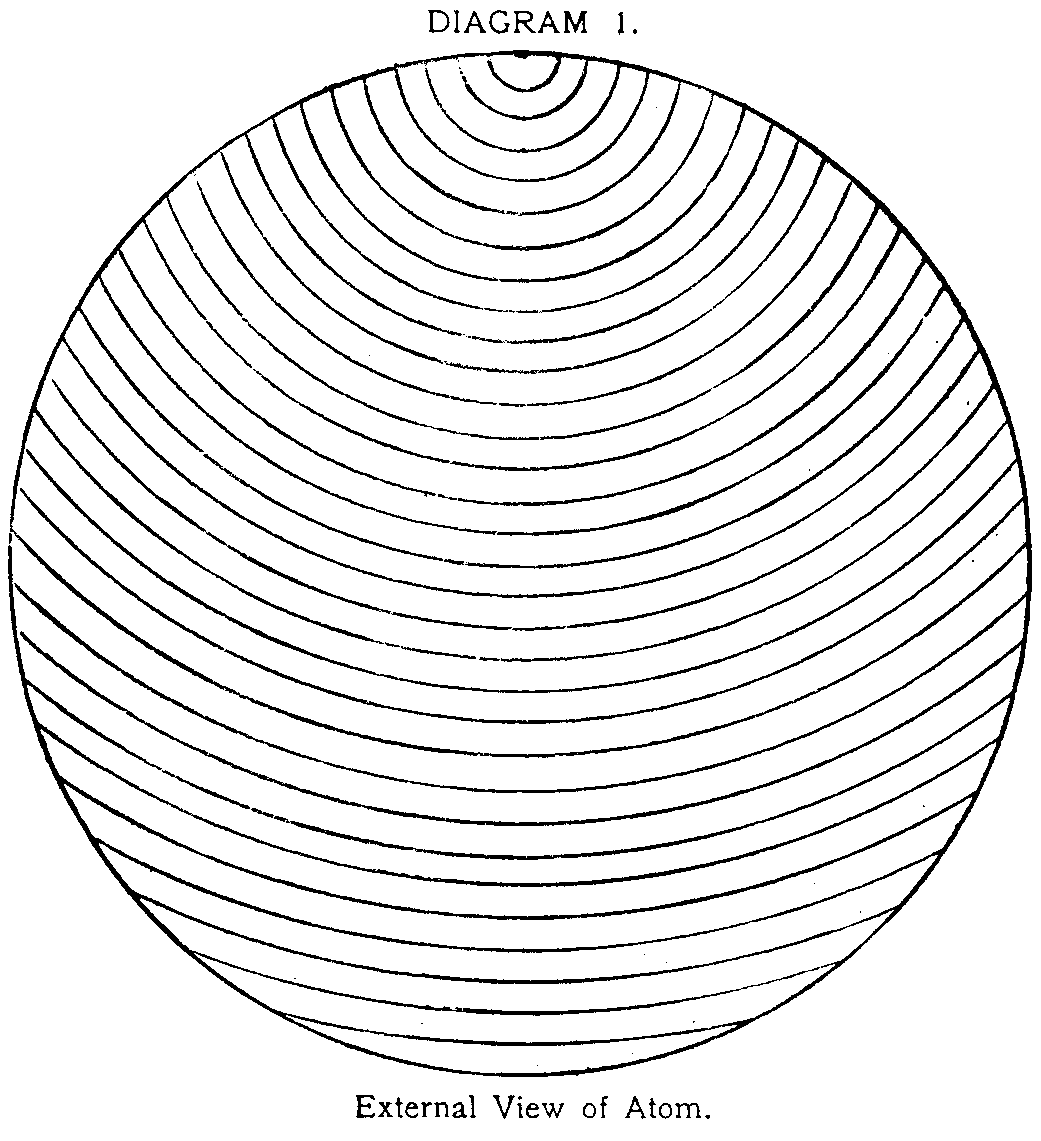
|
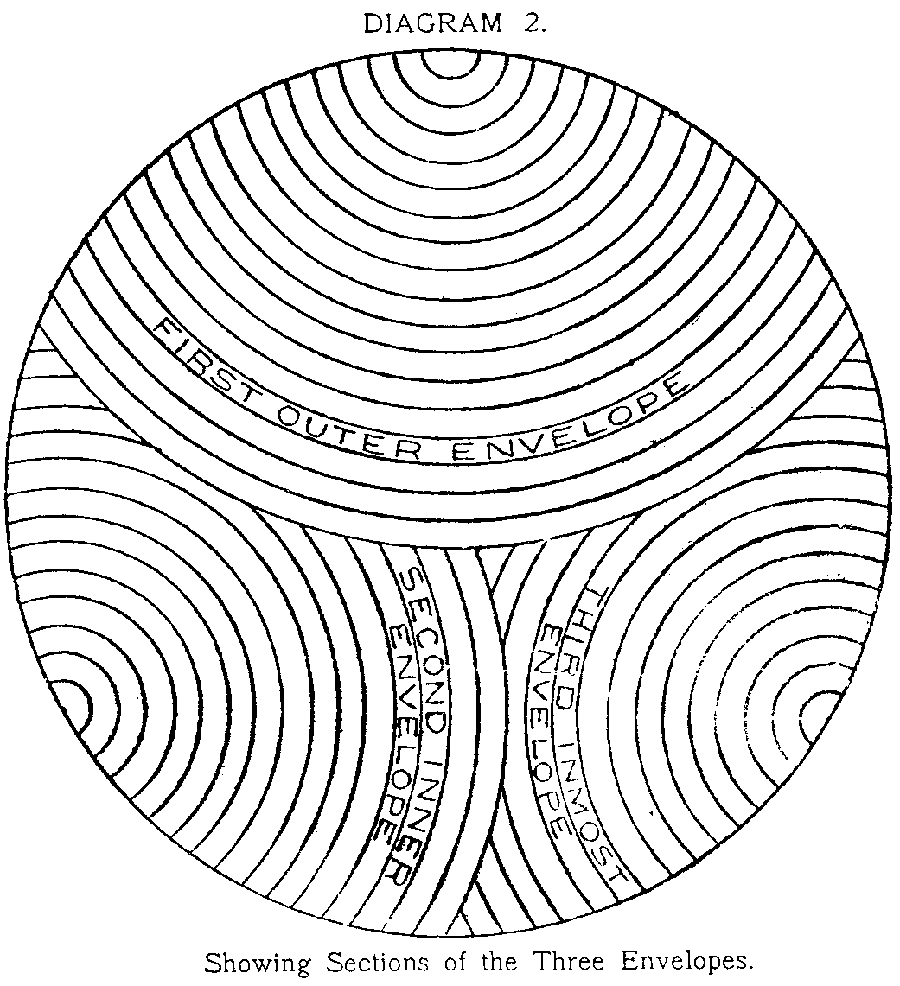
|
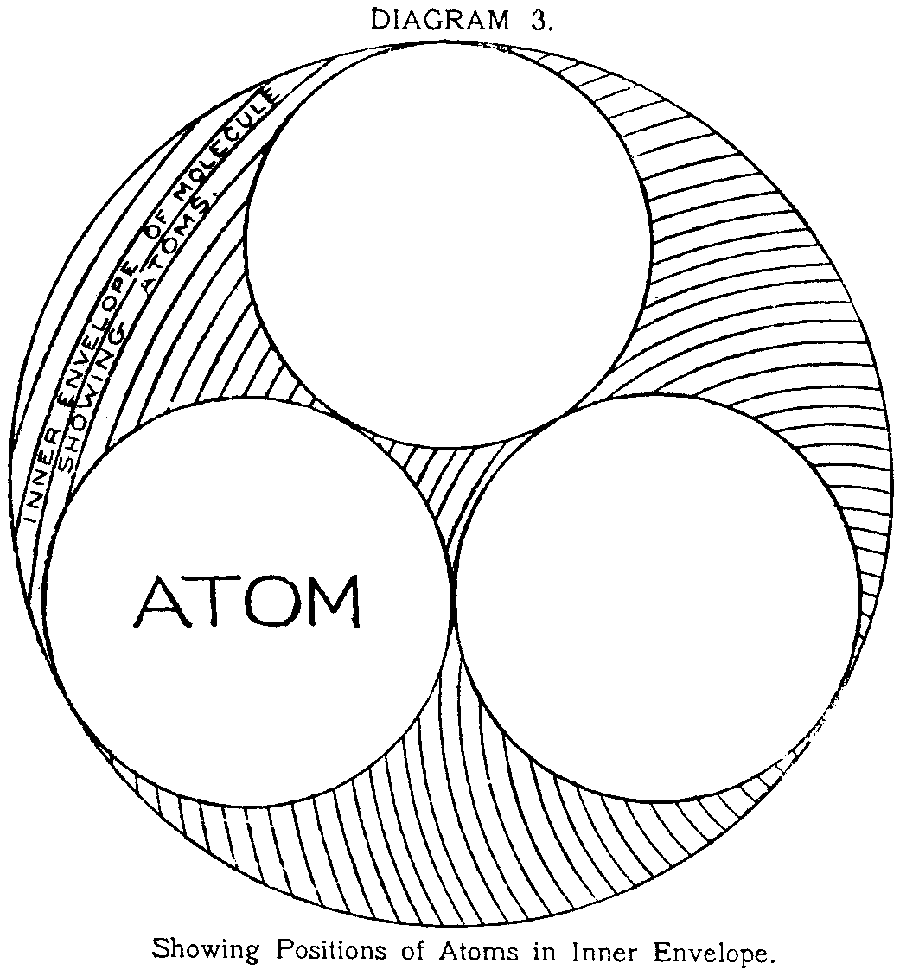
|
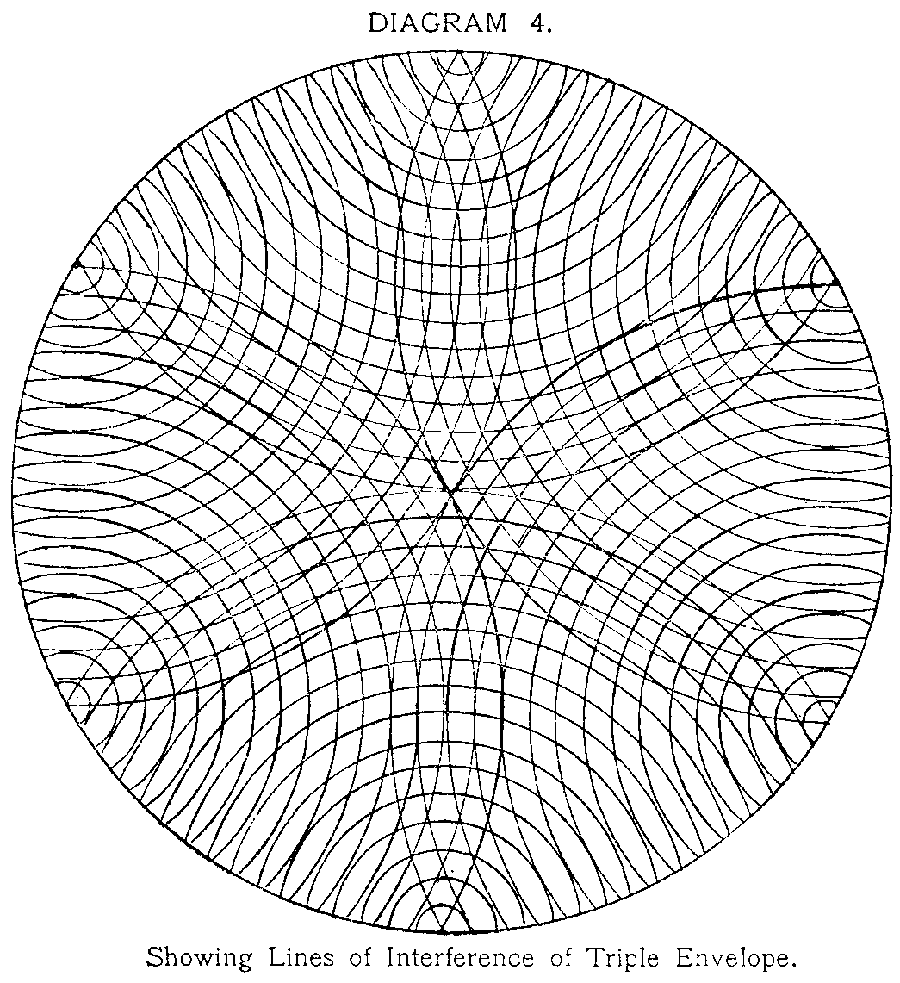
|
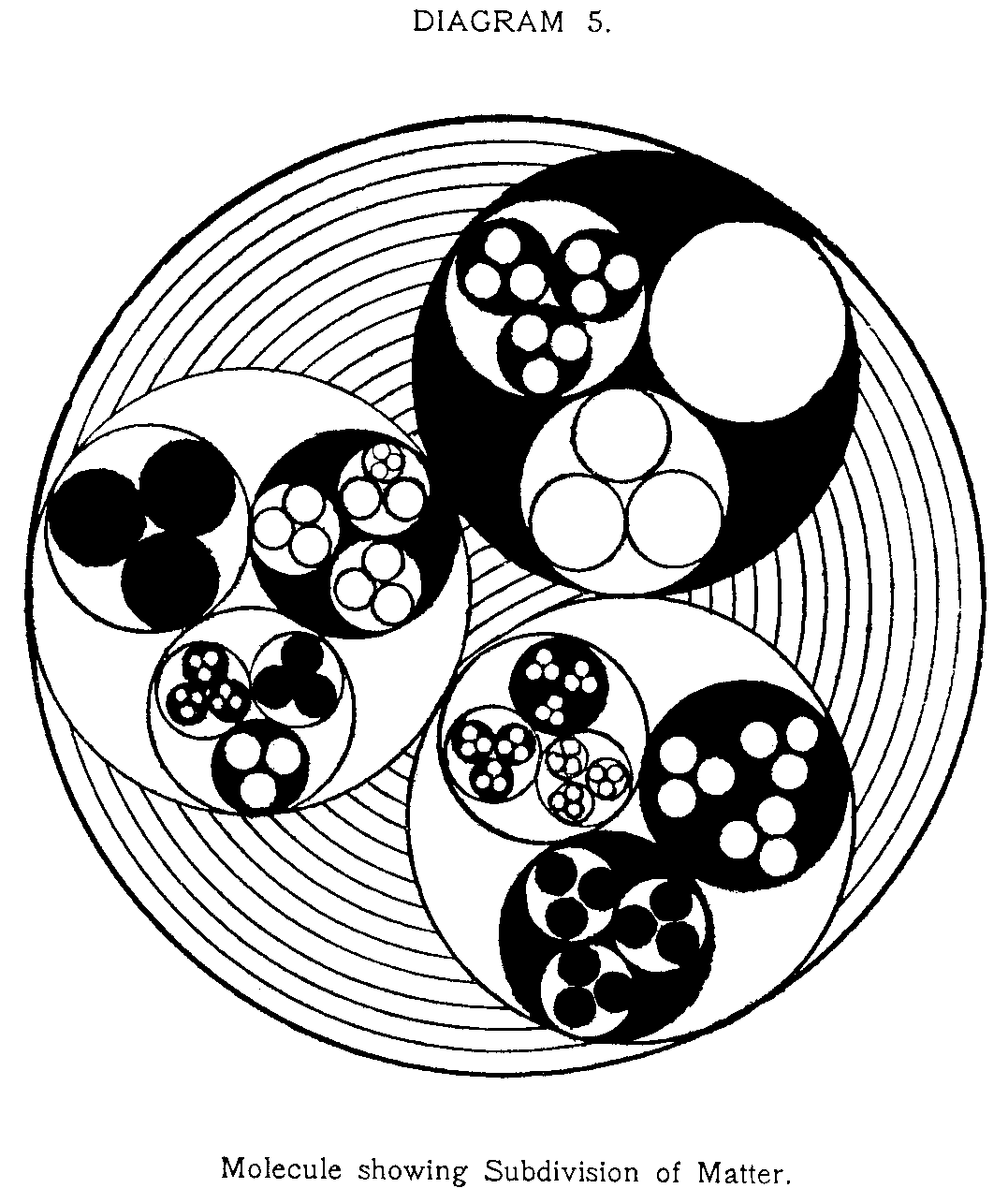
|
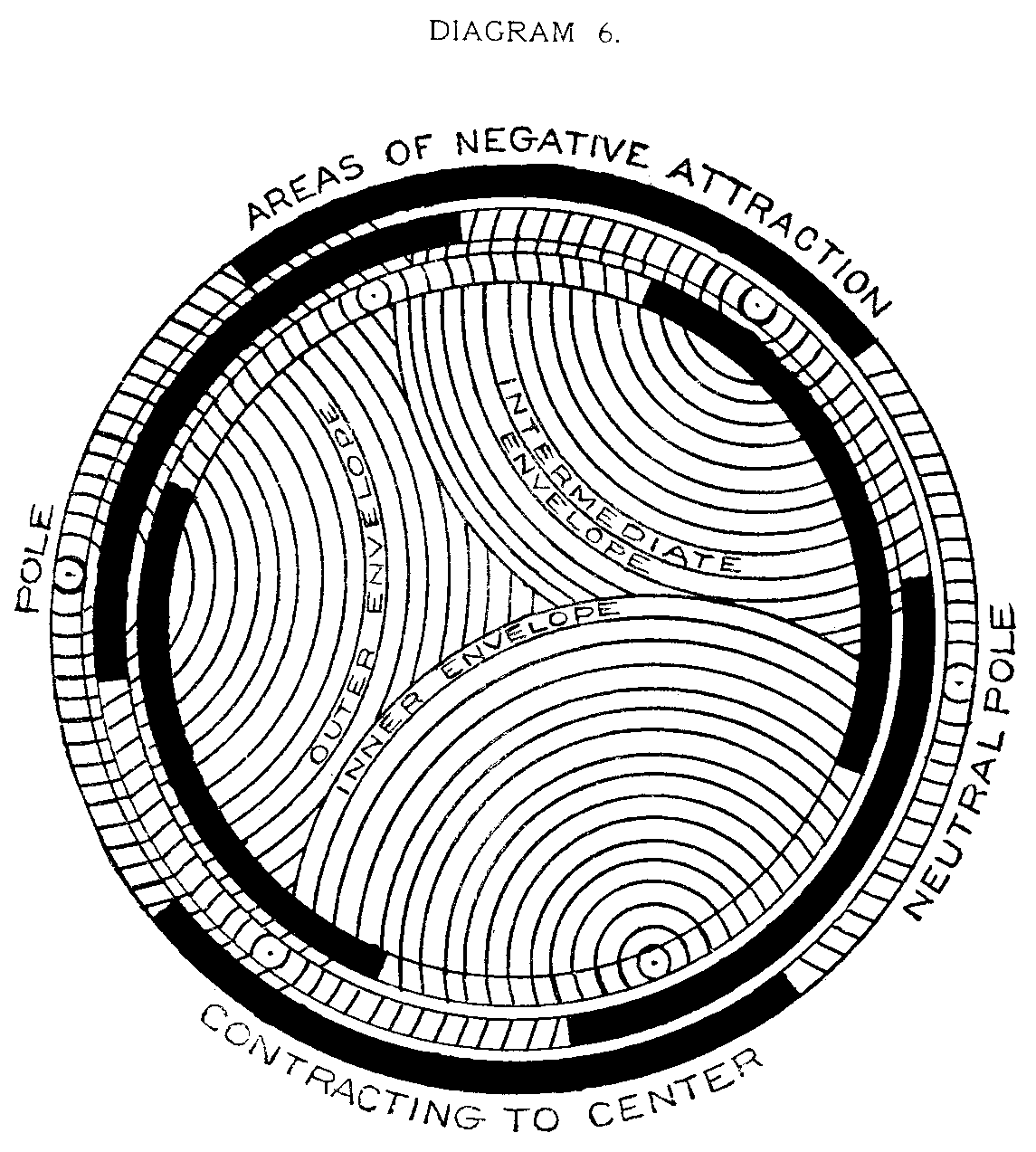
|
(images from Dashed Against the Rock)
See Also
Atomic Triplet
atomic triplets
Efimov state
Figure 1.9 - Keelys Molecular Morphology
Figure 4.12 - Keelys Formative Structural Dynamic Morphology
Figure 4.14 - Feynmans Triplet Structures of the Proton and Neutron
Figure 7.6 - Keelys Triune Morphology
Figure 7.7 - Keelys Morphology - Infinite Subdivision of Matter
Table 15.02 - Triune Polar Streams
triune polar flows
Triune States of Matter and Energy
Resonantly Interacting Particles can form weakly bound Trimer States very important paper
Ultimate Constitution of Matter and Action of Force Regulating its Phenomena
In orthodox science the wide array of quantum entities has been explored to reveal the specific identities and characteristics of individual fine elements such that there are currently recognized muons, leptons, etc. and all the other subatomic or quantum entities. All of which were lumped together as the "ether" in previous times most notably during that Victorian time when atoms were considered to be the smallest possible particle which was held to be indivisible into anything smaller. Since about 1890 it was gradually learned the atom was not indestructible and indivisible but could in fact be divided into its constituent component parts. [See Quantum Chronology below] These constituent parts taken as a whole was the ether. Today these parts have been individually identified as the various quantum elements known now as muons, leptons, etc.
As molecules are composed of atoms, atoms are composed of identified quantum entities or the unidentified elements of ether (etheric elements) as shown in Figure 3.
There are countless etheric elements (quantum entities). These subtle elements have many attributes. At the finer higher state (seventh subdivision) etheric substance is the same as Undifferentiated Mind. As there is no differentiation of aether at this level there is likewise no differentiation of Mind at this level. Mind or Consciousness is at this level Knowing or Whole Mind. Once differentiation (refraction) occurs Knowing Mind becomes Thinking Mind of the ego or intellect.
A Recent History Of Æther Research.
I have been looking into the post Michaelson and Morley research and experimental data, and I was surprised at what I ended up finding. It started while looking up Dayton Miller who was an American physicist, he conducted a series of experiments from 1902 to 1933 in an attempt to detect the motion of the Earth through the luminiferous aether.
Miller's experiments were based on the Michelson-Morley experiment, which had failed to detect any motion of the Earth through the aether. However, Miller claimed to have found a small but significant effect, which he interpreted as evidence of the Earth's motion through the aether. As I found his results were controversial, and many physicists believed that they were due to experimental errors. However, Miller's results were also supported by some other experiments.
Miller conducted his experiment at Mount Wilson Observatory in California. He used a long interferometer with two arms that were 22 meters long. The interferometer was located in a basement room that was shielded from vibrations and temperature changes. He made his measurements over a period of 21 years, from 1902 to 1933.
He took measurements at different times of day, different seasons, and different years. He also took measurements during solar eclipses, when the Earth's atmosphere was blocked out. Miller's results showed a small but significant difference in the speed of light in the two directions. This difference was consistent with the Earth's motion through the aether. Miller published his results in a series of papers in the 1920s and 1930s.
And as I said there were a couple other experiments that supported Miller's results.
One was the Sagnac experiment, which was conducted by French physicist Georges Sagnac in 1913. The Sagnac experiment used a rotating interferometer to measure the speed of light in two directions, one parallel to the Earth's rotation and one perpendicular to the Earth's rotation. Sagnac found a difference in the speed of light in the two directions, which he interpreted as evidence of the Earth's motion through the aether.
Another experiment that supported Miller's results was the Illingworth experiment, which was conducted by British physicist Arthur Illingworth in 1921. The Illingworth experiment used a rotating mirror to measure the speed of light in two directions, one parallel to the Earth's rotation and one perpendicular to the Earth's rotation. Illingworth found a difference in the speed of light in the two directions, which he interpreted as evidence of the Earth's motion through the aether. [anon]
Ether [1]
- https://chatgpt.com/share/67557c17-3550-800d-a3a3-c851654e8933
- ChatGPT revisits "ether" and creates a much more detailed and thorough discussion with math [12/9/24]: [1] https://chatgpt.com/share/6756eb15-3280-800d-8056-a2fa1ee7ad12
Ether Density [1]
Etheric Realm [1]
- ChatGPT examines the etheric (quantum) realm of matter and energy [12/31/24]: https://chatgpt.com/share/6773cfe2-5854-800d-96cf-871da10625ba
- ChatGPT Analysis of Electricity (electron flow) as an Etheric Disturbance [2/13/25]: [1] https://chatgpt.com/share/67adcb50-c734-800d-a3f1-6f36af4a8d3a
- ChatGPT explores Bearden, Heaviside, Syntropy and Free Energy [2/7/25]: [1] https://chatgpt.com/share/67a60454-0ca0-800d-aaab-9c8b639be79f
- Merging Poynting current and Heaviside component to achieve COP >1 [3/9/25]: https://grok.com/share/bGVnYWN5_7c78f02d-6c8f-4dcc-9fbb-29c002b4f819
Etheric Vapor [1]
See Also
AI Interpretations of SVP
1.21 - It Really Is a Musical Universe
Aether
Cause
Chronology
Compound Interetheric
Connecting Link
Ether
Ether - Keely
Ether - Pond
Ether - Russell
Etheric Elements
First Cause
Keely Chronology
Mind
Neutral Center
Overtone Series
Plasma
quantum chronology
Subdivision
Void
What Ether Is
